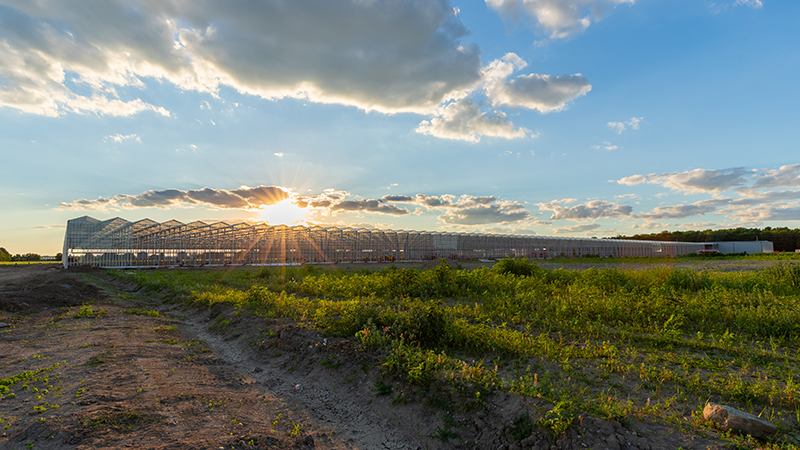Today’s Market Conditions Are a Golden Opportunity for the Greenhouse Lettuce Industry

Photo: Shutterstock
Hot weather this summer has lowered yields, reduced quality, and increased the prices of produce, especially leafy greens such as lettuce. Grocery store buyers are paying more and still experiencing extended shortages, which are causing them to raise prices, change their buying habits, and look for alternatives. These challenges are problematic for traditional growing regions, and an opportunity for controlled-environment agriculture and small farms across the U.S., which have seen increases in production in the last decade.
When everything is working, it is risky to try new things. However, when facing higher prices and shortages, it is risky to stay the course. Exploring new options is the smart business decision. Some experiments will work and be adopted as the new standard. Others will revert to the previous normal.
Currently lettuce is grown in every state, but California and Arizona account for more than 95% of the production. This concentration could diffuse further, providing growers with a high-value item to sell. Since buyers are forced to look for new suppliers, controlled-environment agriculture is a natural fit. These trial sales will be a test for how well these grocers and growers can work together, and if consumers like the product. If controlled-environment agriculture can provide local, high-quality, reliable solutions and capture market share, this could be a turning point for a maturing industry looking for a new stronghold. It could dramatically reshape the U.S. lettuce markets.
Disruptions and Opportunities
Grocery stores are experimenting with sourcing, in-store displays, and prices. They are purchasing from other growing regions like Canada, Ohio, Florida, and New Jersey, as well as from local farms. In-store changes include reducing produce shelf-space and offering discounts to move product through the stores faster to reduce shrinkage. While other growing regions might be reliable this year, weather challenges, labor shortages, and other supply chain disruptions could impact these new areas next year. Indoor agriculture does not face many of these uncertainties. Thus, it is uniquely positioned to leverage this period of uncertainty, because it reliably provides a predictable and high-quality product.
Historically, the challenge for the controlled-environment agricultural industry was a higher cost of production compared to major outdoor growing regions. Convincing grocery buyers and consumers that indoor agriculture was worth the extra cost was difficult. But not today. During inflationary periods, consumers expect to pay more. Plus, the price difference is not as high as normal since conventional lettuce prices have reached their highest levels since 2006, according to Rabobank’s North American Agribusiness Review. This allows consumers to try this new product without making a large investment.
 Beyond Price
Beyond Price
There are several reasons why grocery stores will not balk at higher prices.
- Having product on the shelves is more important than the prices.
- Consumers are willing to pay more for produce and grocery store profitability is determined by the value of a basket of groceries not an individual item.
- For grocery stores, the basket is more important than making money on any one item.
Stores without products to sell will go out of business quickly. Therefore, securing a reliable supply is critical, and sometimes reliably delivered products cost more. If California and Arizona are the cheapest suppliers and reliable, they get the sale. But, when facing shortages, buyers will pay a premium for certainty.
Grocery stores can pass along the higher price of lettuce to consumers. In-store cash register data supports that consumers are willing to pay more for produce. Produce prices increased by 11% and purchases only fell by 5%. Right now, prices are rising faster than sales are dropping.
Finally, grocery store profitability is tied to basket profitability, not to any one item in the basket. Complements, or products that are bought together, have strong relationships in grocery stores. When a consumer purchases lettuce, they also buy tomatoes, salad toppings, and salad dressing. If they do not buy lettuce, they will not purchase these other things. So, grocery stores might be willing to sell leafy greens at a tiny profit or even a loss, because they can make high profits on the complements, making it valuable to sell this low margin item. The profit comes at a whole basket level, not the sale of one item.
Gaining Traction
Grocery store buyers make purchasing decisions with all these factors in mind. Indoor agriculture is insulated from weather problems because it is controlled-environment agriculture and automation helps with labor challenges. Both labor and weather are a threat to agriculture in California and Arizona. With this year’s challenges top of mind, many buyers might be hesitant to source from new regions that might also face these challenges, which leaves indoor agriculture in a good spot.
Indoor growers that leverage the current situation, build relationships, and expand sales will be in the best position to capitalize on the grocery industry’s short-term need for new sources. The high cost of indoor production has forced the industry to grow high-value crops, which aligns perfectly with what grocery stores are demanding. Once these relationships are built, indoor agriculture can expand its footprint into supplying year-round, fresh produce locally.









